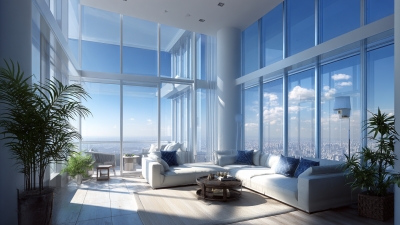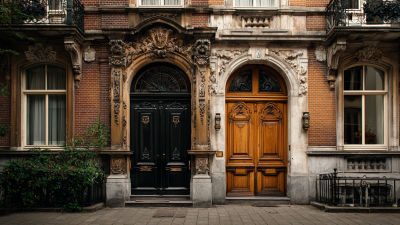Exploring Alternative Designs for Doors and Windows: Innovative Options for Every Home
As homeowners increasingly seek to enhance both the aesthetic and functional aspects of their living spaces, the demand for innovative designs in doors and windows has surged. According to a recent industry report from Grand View Research, the global market for windows and doors is projected to reach $500 billion by 2025, driven by trends in home renovation and sustainable building practices. This growing interest underscores the importance of exploring alternative designs that not only fulfill practical needs but also elevate the overall style of homes. From energy-efficient models to customizable options that reflect individual tastes, the realm of doors and windows offers a wealth of solutions tailored to diverse home environments. As we delve into the innovative options available, it becomes clear that the right door and window designs can dramatically transform spaces, promoting both comfort and environmental responsibility.

Table of Contents
[Hide]
Unique Materials for Door and Window Designs: Enhancing Durability and Aesthetics
The design of doors and windows is evolving, with an increasing focus on unique materials that enhance both durability and aesthetics. Recent studies indicate that the global market for window and door materials reached approximately $200 billion in 2022 and is projected to grow at a compound annual growth rate (CAGR) of 5.3% through 2030. Homeowners are increasingly interested in materials such as fiberglass, composite, and aluminum-clad wood, which offer stronger performance compared to traditional options.

Fiberglass doors, for instance, provide exceptional insulation and resistance to moisture, making them ideal for diverse climates. According to the American Institute of Architects, homes equipped with high-performance windows and doors can save up to 30% on energy costs annually. Moreover, the emergence of composite materials, which combine the best features of wood and vinyl, presents homeowners with visually appealing designs that are less prone to warping and shrinking. As sustainability becomes a priority, many manufacturers are also turning to recycled materials, further enhancing the appeal of innovative designs in the modern market.
Energy Efficiency Benefits of Innovative Door and Window Options
When considering home renovations or new constructions, the significance of energy efficiency cannot be overstated. Innovative door and window designs play a crucial role in enhancing a home’s energy performance. Modern options, such as triple-glazed windows and insulated doors, not only improve thermal insulation but also reduce heating and cooling costs. These advancements help maintain a comfortable indoor climate while minimizing reliance on HVAC systems, making them an eco-friendly choice.
Moreover, the use of sustainable materials, such as reclaimed wood or recycled aluminum, in door and window constructions contributes to a reduced environmental impact. Manufacturers are now offering products coated with low-emissivity (Low-E) glass, which reflects heat during the summer and retains warmth during winter. This kind of technology can lead to significant energy savings over time. By choosing these innovative designs, homeowners can enjoy both aesthetic appeal and functional benefits, ensuring their homes are not just stylish but also aligned with sustainable living practices.
Maximizing Natural Light: The Advantages of Large Windows and Open Concepts
 Natural light is a critical element in modern home design, not only for its aesthetic appeal but also for its numerous psychological and physiological benefits. According to a report by the American Institute of Architects (AIA), homes with expansive windows and open floor plans have been shown to enhance mood and productivity. Approximately 75% of homeowners believe that natural light is essential for their well-being, making large windows a focal point in innovative home designs.
Natural light is a critical element in modern home design, not only for its aesthetic appeal but also for its numerous psychological and physiological benefits. According to a report by the American Institute of Architects (AIA), homes with expansive windows and open floor plans have been shown to enhance mood and productivity. Approximately 75% of homeowners believe that natural light is essential for their well-being, making large windows a focal point in innovative home designs.
Furthermore, studies indicate that maximizing natural light can significantly reduce energy costs. The U.S. Department of Energy highlights that the incorporation of large windows can decrease reliance on artificial lighting by up to 80%, leading to substantial savings on electric bills. This increased focus on energy efficiency aligns with consumer preferences; a recent survey showed that 87% of respondents prioritize energy-efficient features when considering home purchases. By prioritizing large windows and open concepts, homeowners not only create inviting spaces but also contribute to a sustainable living environment.
Securing Your Home: The Role of Advanced Door and Window Innovations
Recent advancements in door and window technology have significantly enhanced home security, providing homeowners with innovative solutions that go beyond traditional designs. According to a report by the National Crime Prevention Association, 34% of burglars enter through the front door, highlighting the importance of having robust door systems. Modern doors are now equipped with smart locks which provide keyless entry and can be managed remotely through smartphones. This allows homeowners to monitor and control access, receiving real-time alerts whenever someone enters or exits their home.
Windows also play a crucial role in home security, with innovations like laminated glass and reinforced frames reducing vulnerability. The Glass Association has reported that homes with impact-resistant windows are 70% less likely to experience break-ins. Additionally, the integration of security features such as window sensors, which can alert homeowners of unauthorized openings, further enhances surveillance.
These advanced technologies not only protect residences but also provide peace of mind to homeowners, demonstrating that a thoughtful approach to door and window design can significantly improve overall home security.
Customization and Personalization: Making Your Home Truly Yours with Design Choices
In today's world of home design, personalization is key to creating a space that truly reflects your tastes and lifestyle. When it comes to doors and windows, homeowners are increasingly seeking customization options that allow them to express their individuality. Whether it’s choosing a unique color, selecting an unconventional material, or designing a custom pattern, these choices can transform ordinary entryways and viewpoints into stunning focal points that enhance the overall aesthetic of a home.
Beyond aesthetics, personalized doors and windows also offer functional benefits. Custom designs can improve energy efficiency by optimizing fit and insulation. For example, double-glazed windows tailored to specific dimensions can minimize air leakage, leading to lower energy bills. Additionally, incorporating unique locking mechanisms or smart technology allows homeowners not only to enhance security but also to tailor access control to their needs. By considering personalization in both design and function, homeowners can create an environment that is not only visually appealing but also aligns with their practical requirements.
Related Posts
-

Exploring Unique Alternatives to Traditional Big Windows for Modern Spaces
-

Innovative House Door Designs That Transform Your Home and Boost Energy Efficiency
-

Ultimate Guide to Choosing the Perfect Style Windows for Your Home
-

Innovative Designs for Doors and Windows That Transform Spaces Globally
-

What are the Benefits of Choosing Energy Efficient Windows for Your Home
-

The Comprehensive Handbook for Choosing the Perfect Residential Doors